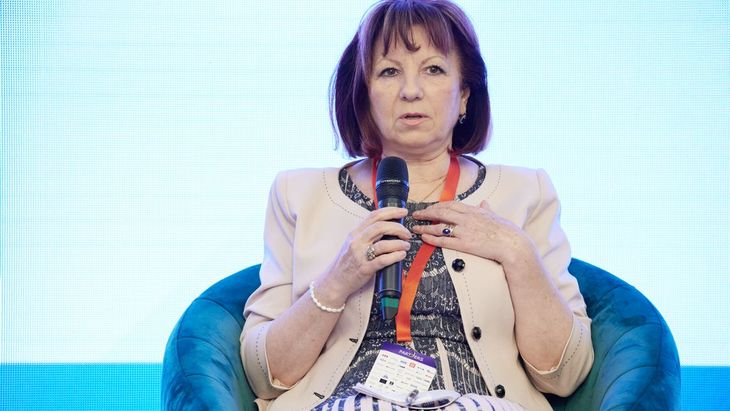Romania aims to install renewable energy capacities of 10 GW by 2030, of which 2 GW are to be installed in the next two years, and another 3 GW by 2025, said Elena Popescu, Director General of the General Policy Directorate Energy and Green Deal from the Ministry of Energy, at the 9th edition of the Energy Strategy Summit, an event organized by Energynomics.
“We proposed 10 GW in wind and photovoltaic until 2030 because this is also a milestone in the PNRR and we are forced to conclude contracts for 1,500 MW this year. We have split the 10 GW scheme into two, 5 GW we want to make accelerated and the rest to follow the path of assessment on state aid schemes. We will go for 5 GW by 2025, of which 2 GW will be this year and 3 GW in 2025. This year there will be an auction for 2 GW and another in 2025 for 3 GW,” said Popescu.
The decarbonization strategy was recently submitted to the European Commission and Romania chose the most ambitious scenario to achieve climate neutrality in 2050. At the same time, by June 30, Romania must submit to Brussels the revision of this plan, but it is in a “slight delay”. In the integrated national plan, each economic sector must establish targets and measures to achieve them, and the EC’s claims are high.
Romania supports the use of technologies with low carbon emissions, taking into account the fact that it is located in a vulnerable geographical area where access to gas or electricity from neighboring states is not always easy. The authorities are also working on the creation of a gap mechanism which is “beginning to take shape” and which is meant to support the adoption of low-carbon technologies. This intention has already been notified to the European Commission.
For this reason, Romania’s main goal is to secure its electricity and gas needs, and to obtain it, it must use all resources with low carbon emissions, including natural gas. In 2030, Romania will have to reach a renewable energy target that cannot be lower than 33-34% of gross consumption at the national level. For the success of this plan, the authorities must provide predictability to investors and stability in the recovery of the investment.
“It’s not about speed, but we have to be very careful about energy security, especially since the decision was made to eliminate coal by 2030. Gas ensures flexibility and enables the accelerated growth of renewables. The 2030 renewables target must take into account what can be achieved at a sectoral level. We are ambitious in vain if there are problems at the sectoral level. We need to establish some realistic targets for Romania. There are many investments in clean technologies that we have to make in order to reach our targets in 2030 and 2050. Without infrastructure, we cannot increase the share of renewables, and here we also consider investments in the transport and distribution network”, said Popescu.
At the same time, Romania is under pressure to accelerate the production of energy from renewable sources, especially since 5,000 MW of production capacity will disappear from the national energy system with the closure, in 2030, of all coal-fired power plants. In addition, between 2027 and 2029 another 700 MW will be unavailable with the entry into the process of upgrading reactor 1 at Cernavodă. Romania relies on reactors 3 and 4 at Cernavodă to compensate for the capacity deficit induced by the closure of the coal sector, and according to Popescu, there will be no problems in putting unit 3 into operation by 2030. These projects are joined by the modular nuclear reactor, which has no delays so far and is likely to be implemented by 2028 or that year. But, from the calculations made by the Ministry of Energy, huge amounts of renewable energy will be needed to cover the hydrogen needs for the decarbonization of industry and transport, and the energy that will be generated by the future modular nuclear reactors lends itself “very well” to the production of hydrogen. “Starting from these data, we must accelerate the production of renewable energy”, added Popescu.
To reduce the impact of these investments on the consumer, Romania intends to use the money from the Modernization Fund in the contracts for difference scheme (CfD). According to Popescu, it is an innovative solution that has aroused the interest of the European Commission and which, if it is functional, could be taken over by other states.
As part of the energy transition, the government has also put the hydrogen strategy for the entire value chain, from production to final consumption, out for public consultation until June 20, after which it will prepare a first draft to be sent to the European Commission. Through the hydrogen strategy, the authorities are trying to create a document as comprehensive as possible, but “it is difficult to give clear directions in the hydrogen economy while there are still directives under debate at the European level”.
“Many people say that there is no room for both renewables and nuclear, but from all our analyzes it appears that there is room because we are not talking about an isolated Romania, but we are in this geographical environment where there is a great need for energy”, Popescu also said.
Energy Strategy Summit 2023 was organised by Energynomics with the support of ABB, ASTRASUN Solar, BCR, CEZ Romania, Eaton Electric, Electrica Furnizare, Electro Service RB, Elektra Renewable Support, EnergoBit, Enevo Group, E.ON, Finder, Huawei, MET România Energy, OMV Petrom, OX2 România, Phoenix Contact, Photomate, ProCredit Bank, REI Grup, Renomia Gallagher, Romgaz, Schneider Electric, Signify, Transelectrica, Taw Energy, Volt, WIKA, Wiren, Alexandrion Group, Aqua Carpatica, Klarmedia and Mobexpert.
